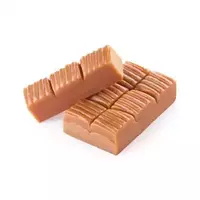Candy iris

The name of the iris sweets comes from the flower of the same name only with French pronunciation - with an emphasis on the last syllable. According to history, for the first time this type of confectionery appeared in the vastness of our homeland in 1902 in St. Petersburg, where it was brought by the French confectioner Josue de Mornas. The fashion for toffee sweets has increased significantly, so when selling the recipe, de Mornas, noticing the similarity of the relief of his products with flower petals, immediately came up with the name of his batch of sweets.
It is clear that this was an ordinary commercial action, since in France itself the iris was known for more than half a century under the name Taffy borrowed from English. But, be that as it may, the first of the names took root in Russia.
Composition of iris
Meanwhile, toffee candy is a type of sweet confectionery. The composition of toffee includes such obligatory components as molasses (molasses), sugar, butter or vegetable oil and condensed milk. Sometimes during the manufacturing process, other components are added - flour, soy protein, as well as flavors, sesame, crushed peanuts and others.
The technology of making toffee sweets consists of sequentially adding and heating components in a special digester, in which products are boiled at temperatures up to 130 degrees. The result is a mixture of sufficiently liquid consistency.
The hot toffee mixture is gradually cooled, after which it becomes thick enough and not particularly viscous, that is, it can be placed in a special apparatus that produces harnesses of molasses of a certain thickness.
Such bundles are supplied to the irisoconverifying machine, where they are cut and wrapped in a label with or without subtraction. It is noteworthy that modern units are capable of wrapping up to three layers of label at the same time, while releasing up to several tons of ready-made toffee sweets into shift.
After wrapping, the product is re-cooled in special tunnels, and then sent to drying chambers, where crystallization occurs at a temperature of about 38 degrees. Due to this stage, the required consistency of the finished product is achieved - for example, semi-solid toffee sweets are obtained from a viscous mass.
Regardless of the composition of the toffee, which always remains unchanged, various forms of this sweetness stand out. So, sweets are produced parallelepiped (bricks), square and molded (poured into arbitrary shapes). According to the method of manufacture, replicated and cast irises are distinguished, and according to the consistency and structure there are the following types: cast semi-solid (such as Golden Key), replicated, semi-solid, soft, viscous (such as Kis-kis or Tuzik). In addition, iris sweets with a filling, coated with glaze or with various additives are often made.
candy iris 391 kCal
Energy value of iris sweets (Ratio of proteins, fats, carbohydrates - ju):
Proteins: 0.03 g (~ 0 kCal)
Fats: 3.3 g (~ 30 kCal)
Carbohydrates: 90.4 g (~ 362 kCal)
Energy ratio (b | y): 0% | 8% | 92%
 Español
Español Français
Français Português
Português Русский
Русский 简体中文
简体中文 繁體中文
繁體中文 日本語
日本語 한국어
한국어 العربية
العربية Türkçe
Türkçe Қазақ
Қазақ Deutsch
Deutsch Italiano
Italiano Українська
Українська
